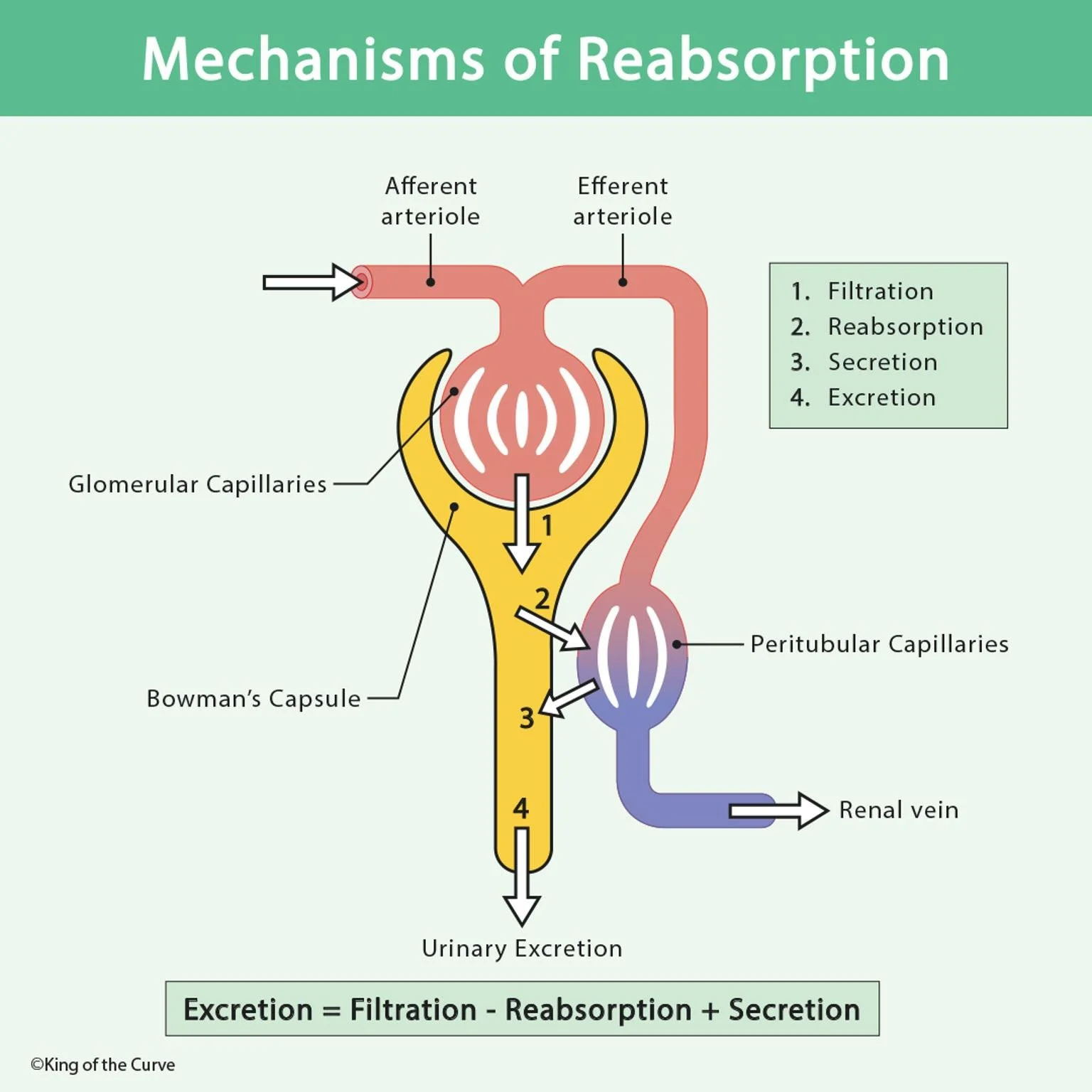💧 Mechanisms of Reabsorption: How the Kidneys Fine-Tune Filtration
Every drop of blood filtered through your kidneys undergoes an incredible balancing act — keeping what your body needs and excreting what it doesn’t. This process, known as reabsorption, is at the heart of renal physiology and appears frequently on both the MCAT and NCLEX.
⚗️ The Science of Renal Processing
The kidney’s job can be summarized in one elegant equation:
Excretion = Filtration – Reabsorption + Secretion
This means that the amount of any substance appearing in the urine depends on:
Filtration — movement of substances from blood into Bowman’s capsule.
Reabsorption — reclaiming of essential substances (like glucose, water, and ions) back into the bloodstream.
Secretion — active transport of waste and excess ions into the tubular fluid.
Excretion — final elimination through urine.
In other words, filtration is your kidney’s starting point, but reabsorption and secretion fine-tune what stays or leaves the body.
📊 Quick Comparison: Key Processes in the Nephron
| Function | Direction of Movement | Example | Energy Requirement | Exam Relevance |
|---|---|---|---|---|
| Filtration | Blood → Tubule | Water, glucose, ions | Passive | GFR calculation (MCAT/NCLEX) |
| Reabsorption | Tubule → Blood | Na⁺, glucose, amino acids | Active & Passive | Diabetes, renal threshold |
| Secretion | Blood → Tubule | H⁺, K⁺, drugs | Active | Acid-base balance, diuretics |
| Excretion | Tubule → Urine | Final output | — | Urine formation, clearance rate |
⚕️ Clinical Connection
Disruption in any step can have clinical consequences:
Decreased filtration → acute kidney injury
Impaired reabsorption → glucosuria in diabetes mellitus
Excessive secretion → altered potassium balance
Reduced excretion → toxin accumulation
On the MCAT, expect passage-based questions connecting GFR (glomerular filtration rate) with physiology equations or drug clearance. On the NCLEX, you might see case studies involving diuretics, electrolyte imbalance, or renal failure.
🔬 Exam Tip: Visualize the Flow
A simple way to remember the direction of flow is:
Blood → Tubule → Blood → Urine
This helps you mentally track where molecules are going — crucial for solving any renal physiology question efficiently.
Try sketching this KOTC image or using our KOTC Visual Library during review to reinforce these steps through pattern recognition and repetition.
🎯 Why King of the Curve Visuals Work
At King of the Curve, we transform high-yield concepts into beautiful, easy-to-remember illustrations. Our visuals are designed to promote active recall and long-term retention — making complex topics like renal physiology simple and engaging.
With over 100,000 downloads, the KOTC app offers:
Adaptive Q-banks tailored to your learning pace
Multiplayer and timed modes
Curve Coin gamification
Interactive visual study tools
🚀 Call-to-Action
Master kidney physiology and much more with our visual learning tools!
👉 Explore the KOTC Visual Library at mcat.kingofthecurve.org
👉 Practice daily at kingofthecurve.org/qotd
👉 Join for free at kingofthecurve.org/free-lifetime
Frequently Asked Questions (FAQs)
-
Aim for 4-6 focused hours, ensuring you incorporate breaks to avoid burnout.
-
Practice mindfulness techniques, take practice exams under realistic conditions, and maintain a balanced lifestyle.
-
Set short-term goals, seek support from mentors, and reward yourself for small achievements.
-
Regular exercise improves focus, reduces stress, and enhances overall mental clarity.
-
KOTC offers personalized learning tools, gamification features, and adaptive question banks to help students stay on track without burnout.


